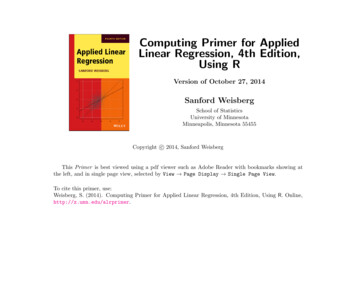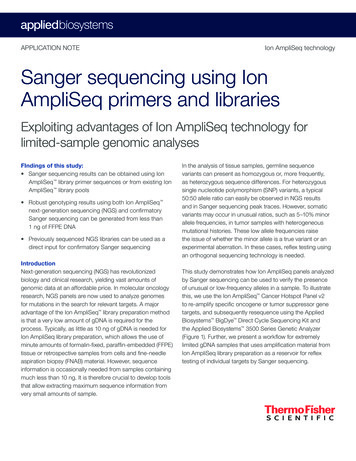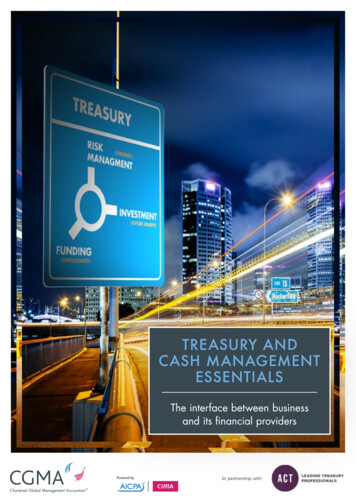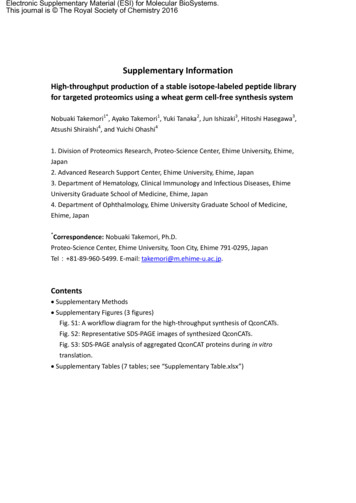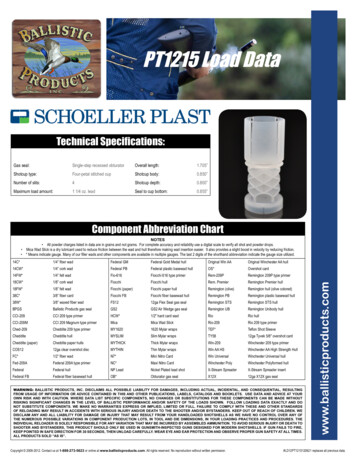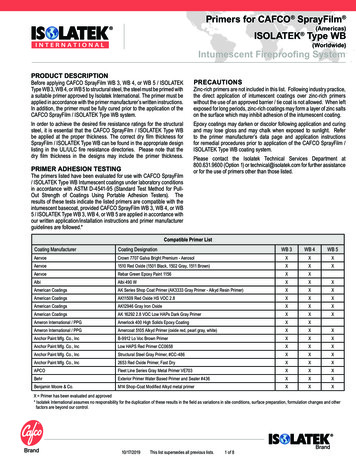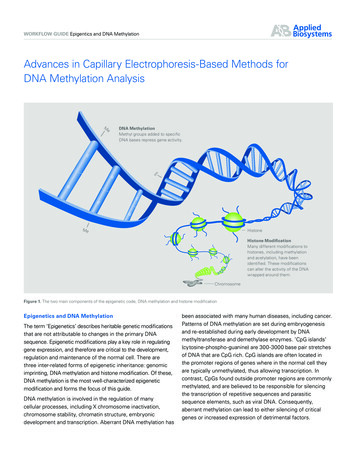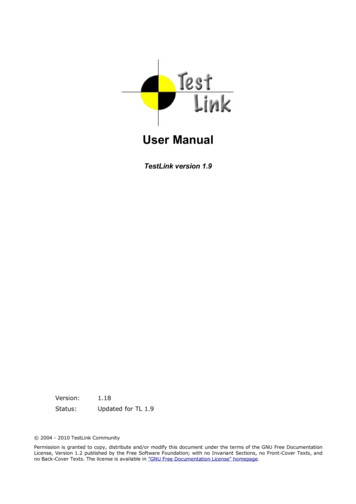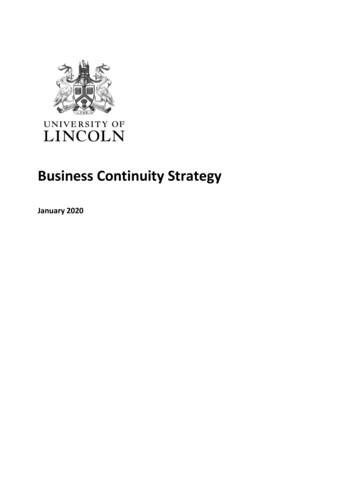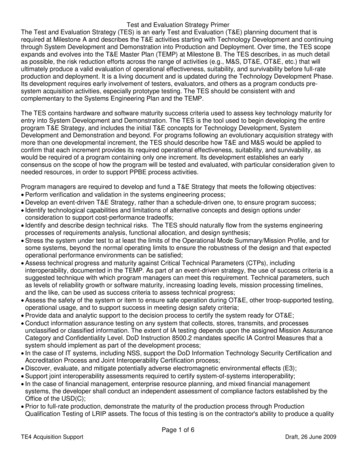
Transcription
Test and Evaluation Strategy PrimerThe Test and Evaluation Strategy (TES) is an early Test and Evaluation (T&E) planning document that isrequired at Milestone A and describes the T&E activities starting with Technology Development and continuingthrough System Development and Demonstration into Production and Deployment. Over time, the TES scopeexpands and evolves into the T&E Master Plan (TEMP) at Milestone B. The TES describes, in as much detailas possible, the risk reduction efforts across the range of activities (e.g., M&S, DT&E, OT&E, etc.) that willultimately produce a valid evaluation of operational effectiveness, suitability, and survivability before full-rateproduction and deployment. It is a living document and is updated during the Technology Development Phase.Its development requires early involvement of testers, evaluators, and others as a program conducts presystem acquisition activities, especially prototype testing. The TES should be consistent with andcomplementary to the Systems Engineering Plan and the TEMP.The TES contains hardware and software maturity success criteria used to assess key technology maturity forentry into System Development and Demonstration. The TES is the tool used to begin developing the entireprogram T&E Strategy, and includes the initial T&E concepts for Technology Development, SystemDevelopment and Demonstration and beyond. For programs following an evolutionary acquisition strategy withmore than one developmental increment, the TES should describe how T&E and M&S would be applied toconfirm that each increment provides its required operational effectiveness, suitability, and survivability, aswould be required of a program containing only one increment. Its development establishes an earlyconsensus on the scope of how the program will be tested and evaluated, with particular consideration given toneeded resources, in order to support PPBE process activities.Program managers are required to develop and fund a T&E Strategy that meets the following objectives: Perform verification and validation in the systems engineering process; Develop an event-driven T&E Strategy, rather than a schedule-driven one, to ensure program success; Identify technological capabilities and limitations of alternative concepts and design options underconsideration to support cost-performance tradeoffs; Identify and describe design technical risks. The TES should naturally flow from the systems engineeringprocesses of requirements analysis, functional allocation, and design synthesis; Stress the system under test to at least the limits of the Operational Mode Summary/Mission Profile, and forsome systems, beyond the normal operating limits to ensure the robustness of the design and that expectedoperational performance environments can be satisfied; Assess technical progress and maturity against Critical Technical Parameters (CTPs), includinginteroperability, documented in the TEMP. As part of an event-driven strategy, the use of success criteria is asuggested technique with which program managers can meet this requirement. Technical parameters, suchas levels of reliability growth or software maturity, increasing loading levels, mission processing timelines,and the like, can be used as success criteria to assess technical progress; Assess the safety of the system or item to ensure safe operation during OT&E, other troop-supported testing,operational usage, and to support success in meeting design safety criteria; Provide data and analytic support to the decision process to certify the system ready for OT&E; Conduct information assurance testing on any system that collects, stores, transmits, and processesunclassified or classified information. The extent of IA testing depends upon the assigned Mission AssuranceCategory and Confidentiality Level. DoD Instruction 8500.2 mandates specific IA Control Measures that asystem should implement as part of the development process; In the case of IT systems, including NSS, support the DoD Information Technology Security Certification andAccreditation Process and Joint Interoperability Certification process; Discover, evaluate, and mitigate potentially adverse electromagnetic environmental effects (E3); Support joint interoperability assessments required to certify system-of-systems interoperability; In the case of financial management, enterprise resource planning, and mixed financial managementsystems, the developer shall conduct an independent assessment of compliance factors established by theOffice of the USD(C); Prior to full-rate production, demonstrate the maturity of the production process through ProductionQualification Testing of LRIP assets. The focus of this testing is on the contractor's ability to produce a qualityPage 1 of 6TE4 Acquisition SupportDraft, 26 June 2009
Test and Evaluation Strategy Primerproduct, since the design testing should already have finished. Depending on when this testing is conducted,the results might be usable as another data source for IOT&E readiness determinations; and Demonstrate performance against threats and their countermeasures as identified in the DIA-validatedSystem Threat Assessment. Any impact on technical performance by these threats should be identified earlyin technical testing, rather than in operational testing where their presence may have serious repercussions.In addition to the mandatory items above, the following items are strongly recommended to ensure a robustT&E program: Involve testers and evaluators, from within the program and outside, early in T&E planning activities to taptheir expertise from similar experiences and begin identifying resource requirements needed for T&Ebudgeting activities; Ensure the T&E Strategy is aligned with and supports the approved acquisition strategy, so that adequate,risk-reducing T&E information is provided to support decision events; Utilize developmental test activities, where appropriate, to include hardware-in-the-loop simulation, prior toconducting full-up, system-level testing in realistic environments; The required assessment of technical progress should include reliability, desired capabilities, and satisfactionof Critical Operational Issues (COIs) to mitigate technical and manufacturing risks; Increase likelihood of OT&E success by testing in the most realistic environment possible; Assess system-of-systems Command, Control, Communications, Computers, Intelligence, Surveillance, andReconnaissance (C4ISR) prior to OT&E to ensure that interoperability under loaded conditions will representstressed OT&E scenarios.There is no prescribed format for the TES, but it should include the following items, to the extent known: Introduction and objectives of the system-specific technical and operational evaluations that will supportfuture decision events; System description, mission, concept of operations, and major performance capabilities from the InitialCapabilities Document. Identify new technology and the plan to identify associated risk; Acquisition strategy concept - For programs following the preferred evolutionary acquisition strategy, the TESshould describe how T&E and M&S would be applied to each increment. It should show how each incrementwould ultimately provide a demonstrated level of operational effectiveness, suitability, and survivability, andmeet user needs with a measurable increase in mission capability; Time-phased threats to mission accomplishment; Anticipated concept of operations, including supportability concept; Technical risk reduction testing, including any new or critical technologies identified in the TechnologyDevelopment Strategy; Anticipated component and sub-system developmental testing that begins after MS A; Test and evaluation strategy for System Development and Demonstration; Critical operational and live fire (if appropriate) issues; Scope and structure of the operational and live fire evaluations; Likely sources of required data; Major T&E design considerations; Hardware and software maturity success criteria; T&E schedule; Anticipated M&S used for future system evaluations; and T&E funding estimates in enough detail to permit programming and budgeting.DoDD 5000.01 requires T&E to be integrated throughout the defense acquisition process and structured toprovide essential information to decision-makers, assess attainment of technical performance parameters, anddetermine whether systems are operationally effective, suitable, survivable, and safe for intended use. T&Econduct, integrated with modeling and simulation, should facilitate learning, assess technology maturity andinteroperability, facilitate integration into fielded forces, and confirm performance against documentedcapability needs and adversary capabilities as described in the system threat assessment. Integrated T&E isPage 2 of 6TE4 Acquisition SupportDraft, 26 June 2009
Test and Evaluation Strategy Primerdefined as: “the collaborative planning and collaborative execution of test phases and events to provide data insupport of independent analysis, evaluation and reporting by all stakeholders particularly the developmental(both contractor and Government) and operational test and evaluation communities.” Overviews of the fourtypes of T&E that should be considered for integration are presented in Table 1.Table 1. T&E Type OverviewsDT&E Controlled by PM One-on-one tests Controlled environment Contractor involvement Trained, experiencedoperators Precise performanceobjectives and thresholdmeasurement Test to specification Development test article Test conditionsdetermined by the PMOT&E Controlled by independenttest agency Many-on-many tests Realistic/tacticalenvironment withoperational scenario Restricted systemcontractor involvement User troops recentlytrained on equipment Performancemeasurement ofoperational effectivenessand suitability Test to requirements Production representativetest article Test conditionsoperationally realistic withtypical users and logisticssupportInteroperability T&E Certification conducted byJITC Operational testingconducted by OTA(s) Includes NR-KPPo Adherence to NCOWReference Modelo Required IntegratedArchitecture Productso Adherence to KeyInterface Profiles (KIPs)o Information Assurance Test conditions reflect anapplicable capabilityenvironmentIA T&E Controlled by OTA, DIA,FSO, NSA System Registration(JCPAT-E and DOD ITRegistry) Interconnectivity andInteroperability CapabilityProfile IT Standards Profile J-6InteroperabilityCertification MemorandumProvided to DocumentSponsor Via KM/DS Test conditions are a mixof operational andlaboratory environmentsIntegrating T&E consists of many aspects, all designed to optimize test scope and minimize cost. For example,separate contractor developmental testing might be combined with governmental developmental test andevaluation, with control being exercised by a combined test organization. Live testing might be integrated withverified, validated, and accredited simulators or computer driven models and simulations, to optimize theamount of live testing required. Another aspect is integrating DT&E with OT&E into a continuum that reducestesting resource requirements and time, or conducting concurrent DT and OT when objectives and realism arecompatible. Another approach is to combine T&E types into a single test event, with data provided to thevarious T&E evaluators equally. There is no single integration solution that is optimum for all programs, buteach program should consider the T&E approaches presented in Table 2 in preparing the T&E strategy.It is important that the DT&E, OT&E, Interoperability or IA objectives are not compromised when integratingT&E. The user community should be involved early in test planning to ensure the statement of desiredcapabilities is interpreted correctly and tested realistically. No single T&E integration approach may be right forevery program. In some cases, in order to maximize cost and schedule savings, a program may use acombination of integration approaches for specific T&E events/activities rather than a single integrationapproach.Whenever feasible, T&E events should be combined, if that supports technical and operational test objectivesto gain the optimum amount of testing benefit for reasonable cost and time. The concept is to conduct asingle, combined test program that produces credible qualitative and quantitative information that can be usedto address developmental and operational issues. Similarly, capability T&E should be taken into account whenfurther T&E schedule compression may be critical to the early fielding of a system component that provides animmediately available operational utility. Concurrent T&E should only be considered when test planners areable to identify those test events that may provide information useful to development and operational testers.Page 3 of 6TE4 Acquisition SupportDraft, 26 June 2009
Test and Evaluation Strategy PrimerTable 2. Integrating Test & Evaluation Approaches: Advantages and LimitationsCombined Test & EvaluationCombined T&E refers to a single test program conducted to support objectives for multiple T&E types. Combined T&E isconsidered when there are time and cost savings. If selected, planning efforts must be coordinated early to ensure dataare obtained to satisfy the needs of multiple agency testers and not compromise any test agency objectives.AdvantagesLimitations Shortens time required for testing and, thus, the Requires extensive early coordination.acquisition cycle. Test objectives may be compromised. Achieves cost savings by eliminating redundant Requires development of common test database.activities. Combined testing programs are often conducted in a Early involvement of OT&E personnel duringdevelopment environment.system development increases their familiarity with Test will be difficult to design to meet DT and OT requirements.system. The system contractor is prohibited by law from participating in Early involvement of OT&E personnel permitsIOT&E.communication of operational concerns to Time constraints may result in less coverage than planned fordeveloper in time to allow changes in systemOT&E objectives.design.Capability Test and EvaluationCapability T&E is a blend of combined and concurrent T&E in that a single test program is conducted to supportobjectives for multiple T&E types. In capability T&E, multiple T&E types may take place at the same time as parallel andcombined activities. The integration of multiple T&E types requires early planning and coordination of the test efforts toensure that collected test data meets multiple needs.AdvantagesLimitations Shortens time required for testing and, thus, the Requires extensive early coordination.acquisition cycle. Test objectives may need to be negotiated between the testactivities. Achieves cost savings by eliminating redundantactivities. Requires development of common test database. Focuses on operational utility. Test environment may not be fully operationally realistic. Early involvement of OT&E, Interoperability, and IA If system design is unstable and far-reaching modifications arepersonnel during system development increasesmade, OT&E must be repeated.their familiarity with system. Test design to meet multiple T&E type requirements is a Integration of multiple T&E types permits earlychallenge.communication of concerns to the developer that The system contractor is prohibited by law from participating infoster cost-effective changes in system design.IOT&E. Provides earlier feedback to the development Time constraints may result in less coverage than planned forprocess.OT&E/Interoperability/IA objectives.Concurrent Test & EvaluationConcurrency is defined as an approach to system development and acquisition in which phases of the acquisitionprocess that normally occur sequentially overlap to some extent. Concurrent T&E refers to circumstances in whichmultiple T&E types take place at the same time as parallel, but separate and distinct, activities.AdvantagesLimitations Shortens the time required for testing and, thus, theacquisition cycle. Achieves cost savings by overlapping redundantactivities. Provides earlier feedback to the developmentprocess. Requires extensive coordination of test assets. If system design is unstable and far-reaching modifications aremade, OT&E must be repeated. Concurrent testing programs often do not have DT dataavailable for OT&E planning and evaluation. Contractor personnel frequently perform maintenance functionsin a DT&E. Logistics support by user must be available earlierfor IOT&E. Limited test assets may result in less coverage than plannedfor OT&E objectives.The T&E Strategy of a system acquired using evolutionary acquisition should address each increment intendedfor fielding. In general, T&E that has previously confirmed the effectiveness and suitability of a previousincrement need not be repeated in its entirety to confirm that the subsequent increment still provides thosemission capabilities previously confirmed. However, regression testing to reconfirm previously testedPage 4 of 6TE4 Acquisition SupportDraft, 26 June 2009
Test and Evaluation Strategy Primeroperational capabilities and/or suitability might be required if the subsequent increment introduces asignificantly changed hardware or software configuration, or introduces new functions, components, orinterfaces that could reasonably be expected to alter previously confirmed capabilities. Tailor test content andreporting against earlier test results, evaluating at a minimum the increment of mission accomplishment andsurvivability required of the new increment, plus whether or not performance previously demonstrated by theprevious increment has been degraded.The use of commercial items and Non-Developmental Items (NDIs) in a system acquisition can provideconsiderable time and cost savings and also influence the overall T&E strategy. The testing approach usedmust be carefully tailored to the type of system, levels of modifications, technology risk areas, and the amountof test data already available. The T&E community must get involved early in the process so that all test issuesare adequately addressed and timely comprehensive evaluations are provided to decision authorities.Test planning for commercial and NDIs shall recognize commercial testing and experience, but nonethelessdetermine the appropriate T&E needed to ensure effective performance in the intended operationalenvironment. The Defense Acquisition Guidebook suggests that “the PM shall develop an appropriate T&Estrategy for commercial items to include evaluating commercial items in a system test bed, when practical;focusing test beds on high-risk items; and testing commercial item upgrades for unanticipated side effects inareas such as security, safety, reliability, and performance.” T&E must be considered throughout theacquisition of a system that involves commercial items and NDI.The TES for programs using commercial items or NDIs will be influenced by the availability of approved T&Eissues and criteria; contractor provided descriptions of the testing previously performed on the commercialitems or NDIs, including test procedures followed, data, and results achieved; identification of PQT and qualityconformance requirements; and acceptance test plans for the system and its components. The amount andlevel of testing required depends on the nature of the commercial item or NDI and its anticipated use; it shouldbe planned to support the design and decision process. At a minimum, T&E should be conducted to verifyintegration and interoperability with other system elements. All commercial item and NDI modificationsnecessary to adapt them to the intended operational system environment are also subject to T&E. Availabletest results from all commercial and government sources will determine the actual extent of testing necessary.For example, a commercial item or NDI usually encompasses a mature design. The availability of this maturedesign contributes to the rapid development of the logistics support system that will be needed and evaluatedduring OT&E. Additionally, more “production” items are available early for use in an integrated T&E program.Since an important advantage of using a commercial item or NDI acquisition strategy is reduced acquisitiontime, it is important that TES reduce redundant testing and that T&E is limited to the minimum effort necessaryto obtain the required data. If it is determined that more information is needed after the initial data collectionfrom the below sources, commercial items or NDI candidates may be bought or leased, and technical andoperational tests may be conducted. Testing can be minimized by: (1) Obtaining and assessing contractortest results; (2) Obtaining usage/failure data from other customers; (3) Observing contractor testing; (4)Obtaining test results from independent test organizations (e.g., Underwriter’s Laboratory); and (5) Verifyingselected contractor test data.All testing conducted after the program initiation milestone decision to proceed with the commercial item or NDIacquisition should be described in the TES and the TEMP. T&E continues after the system has been fieldedand takes the form of an evaluation to validate and refine: operating and support cost data; Reliability,Availability, and Maintainability (RAM); logistics support plans; and training requirements, doctrine, and tactics.T&E is the key mechanism for capturing the quantitative data used to evaluate development progress andreadiness for production and deployment. Accordingly, test must be structured in a way that ensures that thenecessary and sufficient conditions are satisfactorily demonstrated in a timely, relevant manner. It should alsobe noted that while the focus of development and operational test may be different, they have a commonobjective - ensuring that the user obtain systems that are reliable, supportable, and suitable for their needs.Recognizing that test is a continuous spectrum of activities across the acquisition life-cycle, test strategies mayPage 5 of 6TE4 Acquisition SupportDraft, 26 June 2009
Test and Evaluation Strategy Primerbe best categorized by the basis for the criteria that will used to evaluate system performance. From thisperspective, there are three test focuses: end-game, adaptive, and progressive.Table 3. Test and Evaluation Focuses: Advantages and LimitationsEnd-GameConcentrates on the total performance, suitability, and supportability requirements that are to be satisfied by the system.It looks at and evaluates the system from the perspective of final desired parameters.AdvantagesLimitations Most fitted for Single Step to Full Capability with development Assumes the existence of fixed, well definedstrategy that is either waterfall or incrementalrequirements and operational concepts.development without incremental production and Anything less than full compliance with operationaldeployment.requirements can be rated, at best, marginal. Can be used successfully for evolutionary or product Places an additional pressure on the acquisitionimprovement acquisitions when: the end-game criteria aremanagement and user communities when "marginal"down-scaled" to reflect the desired availableperformance" assessments can be used to satisfyperformance, suitability, and supportability characteristics,political agendas.not those of the "completed" system; and the Using an end-game focus for evolutionary or productdemonstrated characteristics are assessed from theimprovement acquisitions can increase the perception ofperspective that quantifiable evidence is present torisk in the management decision-making process, evensupport a claim that "completed" system characteristicswhen the demonstrated core or initial capability fullyare achievable in a cost- effective manner.meets, or exceeds, expectations at a particular point inthe acquisition life-cycle.AdaptiveFocuses on performance, suitability, and supportability requirements for a capability, not a full system, which can beprovided to satisfy a mission need or a portion of that need that has operational utility.AdvantagesLimitations Provides mechanisms for assessing a capability and Does not necessarily keep the total system capability inidentifying those mission elements that would be satisfiedmind.by early fielding of that capability. Places an additional pressure on the acquisition Properly implemented, it ensures that the evaluationmanagement, T&E, and user communities to provideprocess directly relates available performance, suitability,operational utility rather than systems.and supportability levels to a defined military need or Assumes that it is acceptable to partially satisfyportion of that need.requirements and operational concepts.ProgressiveCaptures the desired total system requirements and characteristics and decomposes them into a series of criteria thatprogress from the interim to the core/initial capability to total system level.AdvantagesLimitations Provides mechanisms for assessing development It must keep total system capability in mind, and routinelyprogress, identifying risk elements early, and maintainingprovide demonstrated evidence of progress towards andtest result and evaluation integrity.likelihood of achieving total system capability. Properly implemented, it ensures that the evaluationprocess directly relates available performance, suitability,and supportability levels to defined core/initial, follow-on,and total system capabilities as the system matures.Though best fitted for evolutionary or preplanned product improvement acquisitions, the progressive focus canbe incorporated into any acquisition and development strategy. Development test normally utilizes aprogressive test strategy. This is due to the availability of test assets at the component level early during thedevelopment process and the subsequent integration and test of upper-level components as the systemmatures. This approach also enables development test results to be an integral part of the system's riskmitigation strategy. The adaptive focus is just emerging and is primarily used for the rapid development anddeployment of capabilities rather than systems. Operational test normally uses an end-game test strategy.Accordingly, for evolutionary and product improvement acquisitions, it is imperative that the development,operational test, and user communities define the core/initial capability, follow-on, and total systemcharacteristics in a manner that: retains the integrity of operational test results; and presents evaluations ofavailable capabilities in the context of the desired capabilities for a particular point in the system's life-cycle.Page 6 of 6TE4 Acquisition SupportDraft, 26 June 2009
Strategy IntegrationIt can be contended that the keys to effective planning and execution are: credibility, accountability, andstrategies that work together. Further, these elements must contribute to management's understanding of thedevelopment effort's health by answering four critical questions: (1) "Where are you trying to go?"; (2) "Howare you going to get there?"; (3) "Where are we now?"; and (4) "How good are we?" This understanding canthen be used to identify critical paths, to realistically assess development schedules, and to provide timely,relevant and meaningful information to decision makers. Further, history has shown that if any of thesequestions can not be answered, there is a high likelihood that the program is in trouble. The answers to thefirst two questions lie in credibility, while the answers to the latter two questions lie in accountability.CREDIBILITYCredibility is the key ingredient in implementing a streamlined approach to weapon systems acquisition. Thesystem's developing agency must establish credibility with multiple organizations, primarily the operational user(the customer), the logistics community, independent test agency, and Service staff, Joint Chiefs of Staff,Office of the Secretary of Defense staff, the Congress, and the contractor(s). Credibility is exhibited throughthe existence and use of the various planning (the how you are going to get there) and requirements (thewhere are you trying to go) documents.Credibility Axiom 1: If Don’t Know Where You Are Going And Don’t Care How You Going To Get There,Any Map Will Do.If a developing agency possesses credibility, the development process lends itself to a streamlined acquisition.Conversely, the lack of credibility is an inherent inhibitor of acquisition streamlining. Some examples of how alack of credibility manifests itself may prove useful in understanding how pervasive it can be: A system where the schedules were unrealistic (including non-achievable Initial Operational Capability (IOC)dates), requirements (developmental and operational) ill-defined, and a funding profile that does not supportappropriate system development, test, production, and support capabilities to field the system; System proponents (government or industry), who knew what funds were available, were informed by theirstaff element that the available funds and/or schedule were insufficient to achieve the professed systemrequirements, and still promised the world that the total system could be developed and fielded withinavailable resources; Aa development schedule that was driven by end dates (arbitrary or politically inspired IOCs) instead of aschedule that reflected what was really necessary to meet the requirements (assuming that they wereactually understood, defined, and baselined); and A system that entered Engineering and Manufacturing Development with a plan of three years to deploymentand then watched the development time grow to 5, 7, 11, or 15 years because requirements kept changing,or were poorly understood, defined, or baselined.The existence of planning an
system should implement as part of the development process; In the case of IT systems, including NSS, support the DoD Information Technology Security Certification and Accreditation Process and Joint Interoperability Certification process; Discover, evaluate, and mitigate potentially adverse electromagnetic environmental effects (E3);

